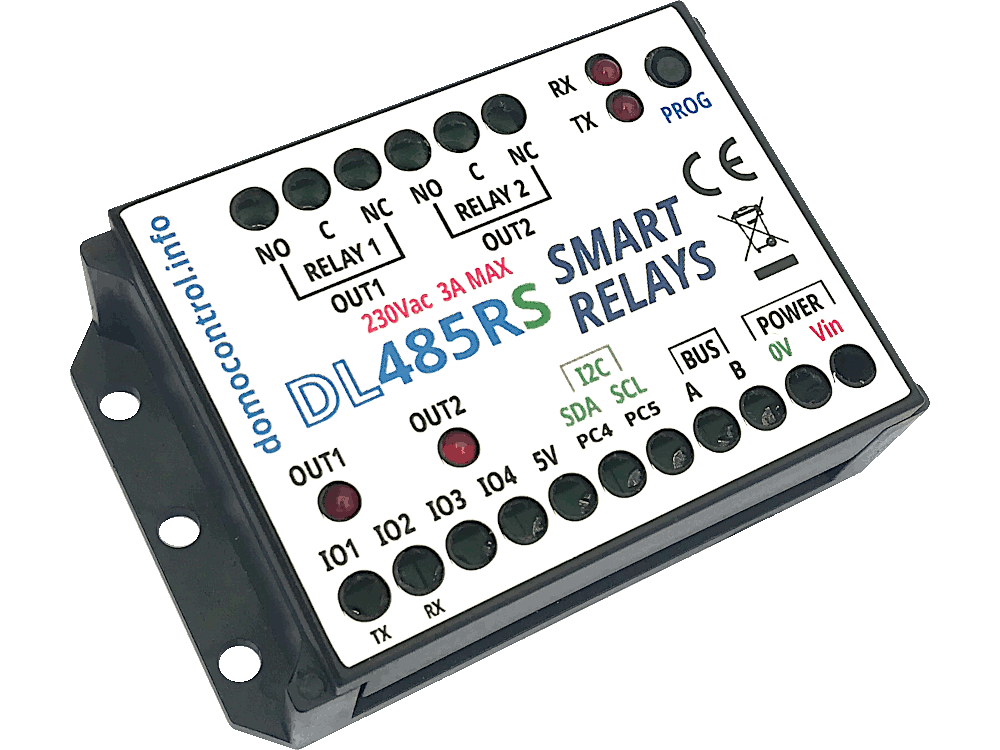
DL485RS - Smart Relay with 2 independent configurable diverter outputs: Step by step - Timer - Flashing light
| Lunghezza | 47.0 mm |
| Larghezza | 74.0 mm |
| Altezza | 25.0 mm |
MULTIFUNCTION SMART RELAY Dal Blog
USER SETABLE AS:
- STEP BY STEP
- TIMER
- FLASHING
- PRESENT MAN
- FORWARD-STOP-REVERSE ENGINE CONTROL
- TIMER ACCELERATION-SWITCHING TIMES
FOR STAR-DELTA STARTING
- TIMED LIGHTS WITH BUTTON COMMANDS
OR SWITCHES / DIVERTERS
- TRIGGERS THAT CAN BE SET ON THE RISING / DESCENT
FRONTS OF ENTRANCES AND
ALL'ARRIVO DELL'ALIMENTAZIONE
OPTIONAL:
- OROLOGIO INTERNO CON BATTERIA TAMPONE
- FUNZIONI DI ACCENSIONE/SPEGNIMENTO ALBA E TRAMONTO
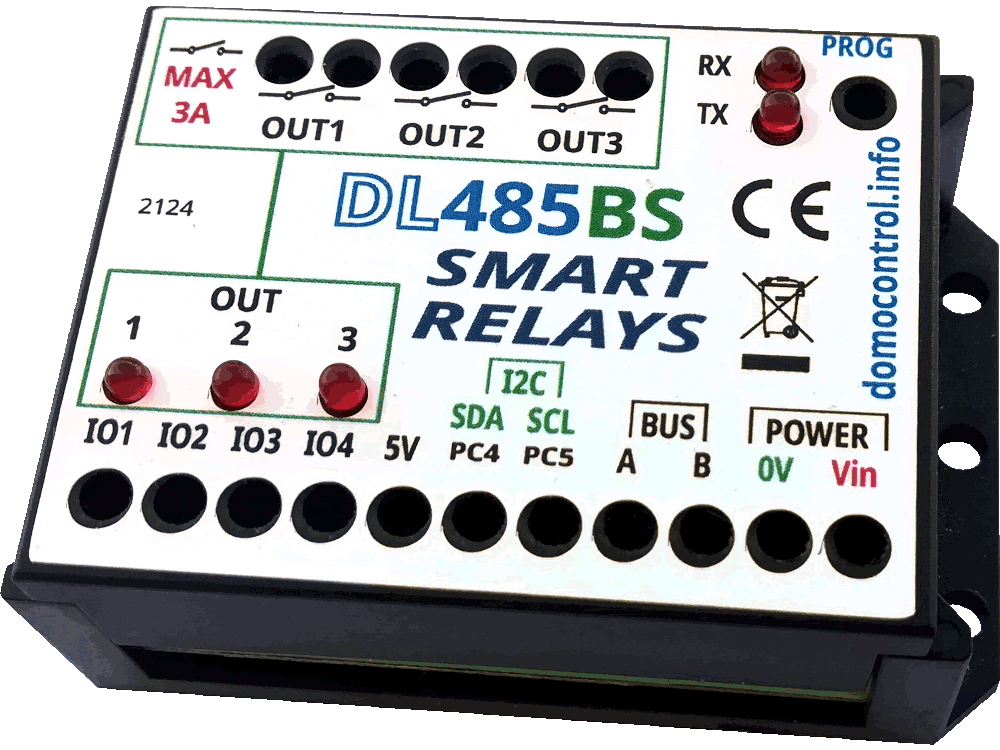
PRODUCT DESCRIPTION
Intelligent programmable relays for multiple uses, available in 2 versions:
- 3 normally open clean contacts
- 2 one-way diverters
with autonomous operation and / or integrable in the 485 network with Domoticz.
The functions of dead man relay, step by step relay, timed relay, intermittent relay, mutual exclusion can be obtained.The operating cycles can be started by on / off variations on the relative input or by the arrival of the supply voltage, and can also be stopped by the input or by the switching on of another relay.
Each relay can have different operating modes based on 13 parameters that can be set through a programming button on the unit and with the help of two indication LEDs.
There are also 32 predefined use cases that can be selected by button in order to quickly approach the case to be configured, and then refine it by modifying some parameters.
Among the various applications there are different types of staircase lighting control, from the simplest ON / OFF, to the most complex that increases the ignition time each time the control is pressed, and with start at ON when the mains voltage returns; then there are different flashing light modes, relay step by step with maximum ignition time, relay in mutual exclusion for forward / reverse / stop engine commands with or without ignition time limit, delayed activation with respect to the arrival of mains voltage, with or without ignition time limit.
In order to satisfy the various possibilities, the configuration parameters are relatively numerous, but they are also simple and intuitive, thus facilitating the achievement of many objectives.
The availability of clean contacts also allows to obtain more complex functions through series / parallel connections.
APPLICATION CASES, EXAMPLES AND SCHEMES
SCALE LIGHT WITH EXTINGUISHING NOTICE
The timers have only 2 times available, ON time and OFF time, therefore it is not possible with a single timer to obtain, for example, a 50-second staircase light that after 40 seconds turns off for 0.5 seconds as a notice of end of time and after another 9.5 seconds goes off definitively, because this case would require programming of three times (40, 0.5 9.5 seconds).
To obtain this result there are different solutions, for example two timers can be connected IN SERIES with the two inputs connected together to have a simultaneous trigger, the first can have an ON time equal to the total cycle of 50 seconds and an OFF time 1 cent with 2 overall commutations, starting with the ON state.
The second timer, connected in series, will have an ON time 40 seconds and an OFF time of 0.5 seconds, with 4 total commutations starting with the ON state, so after switching off for 0.5 seconds it will reactivate for another 40 seconds, but the series will be interrupted after 9.5 seconds from the first timer. Another way IN SERIES is to use a first relay as a staircase light timer and a second relay in series with three ON-OFF-ON switches starting at ON, where the ON time is set at 40 seconds and the OFF time at 0.5. seconds.
Alternatively, the two timers can be connected IN PARALLEL with the first timer having an ON time of 9.5 seconds and an OFF time of 0.5 seconds, with 10 commutations, (1ON + 1OFF 5 times), starting from the ON state, while the second relay, in parallel , with the ON time of 35 seconds it cancels the OFF states of the first timer three times then there will be the fourth OFF state which will be visible, and with the fifth OFF state the cycle ends.The series connection of the contacts is more practical to carry out physically, but the assessments must be made on a case-by-case basis.
If you do not want the switch-off notice, you can avoid connecting the second timer or, without changing the wiring, you can exclude or put back the notice by setting the second timer as the first or as needed for the notice.
Using the third contact and / or changing the times of the timers it is possible to obtain more warning of switching off.
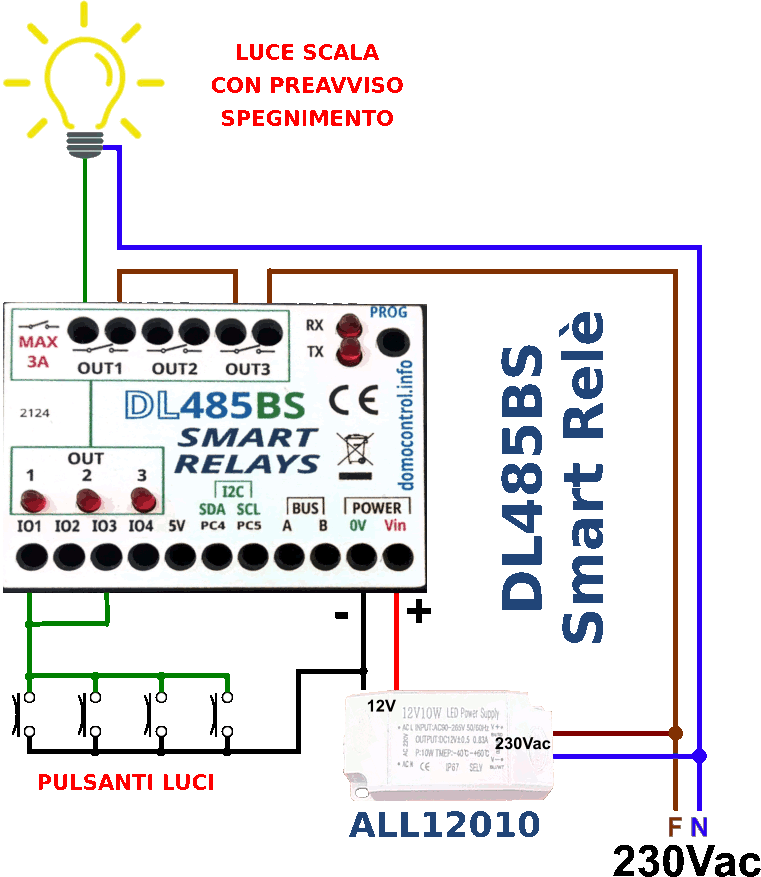
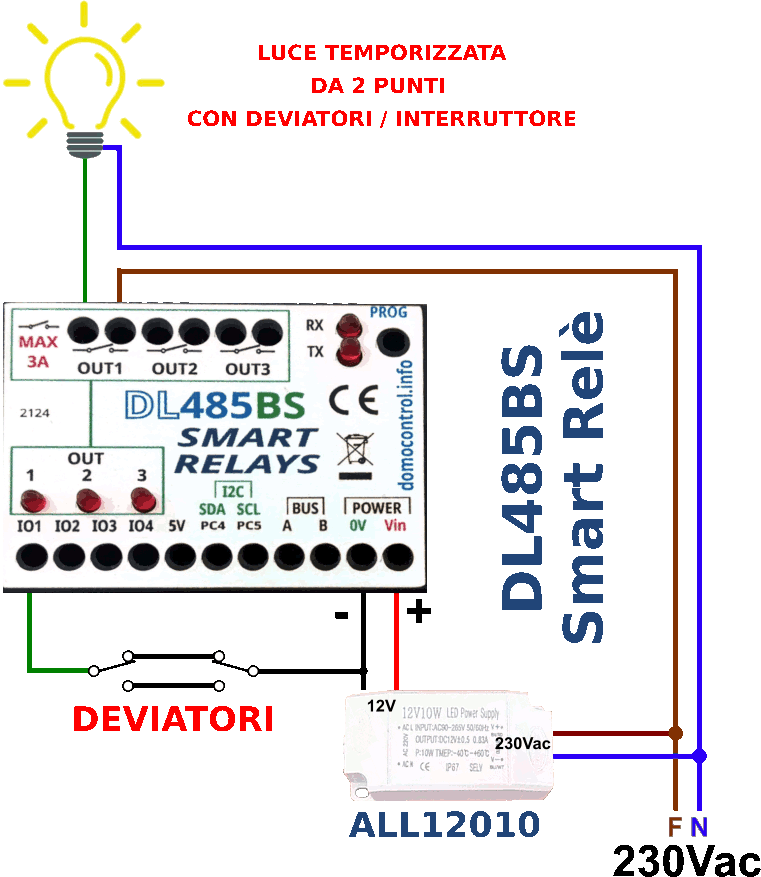
TIMED LIGHT USING DIVERTERS AND SWITCHES INSTEAD OF BUTTONS
When you need to time a light point in an old house where the command is given through switches or deviators, and you do not want or cannot replace the old commands with new buttons, then these permanent commands are used instead of the buttons, setting triggering of the timer on the on and off sides, so that at each change of state of the circuit-breaker or of the series of switches, a new timed cycle will occur.
FORWARD REVERSE MOTORS CONTROL
In the passage from forward to backward direction it is good to go through the completely off state, both for electrical and mechanical reasons, and this device allows you to set the duration of the off time, it is also possible to have the control with two buttons or three buttons, in both in cases it is possible to have the command in toggle on each direction so the button that turns on can also turn off and this is convenient, but it also has limits of use that can be overcome with the three-button system that allows you to turn off the engine by pressing in in any case always the same button and this is especially useful if you do not see the engine or if you do not know in which direction it is turning or if it is turning. Normally when there is an interruption of energy on return the motors must remain off and start only on explicit command, however this unit is flexible and also allows you to establish the start in a certain direction when the mains voltage is restored. It is also possible to set a maximum operating time separately for the two directions.
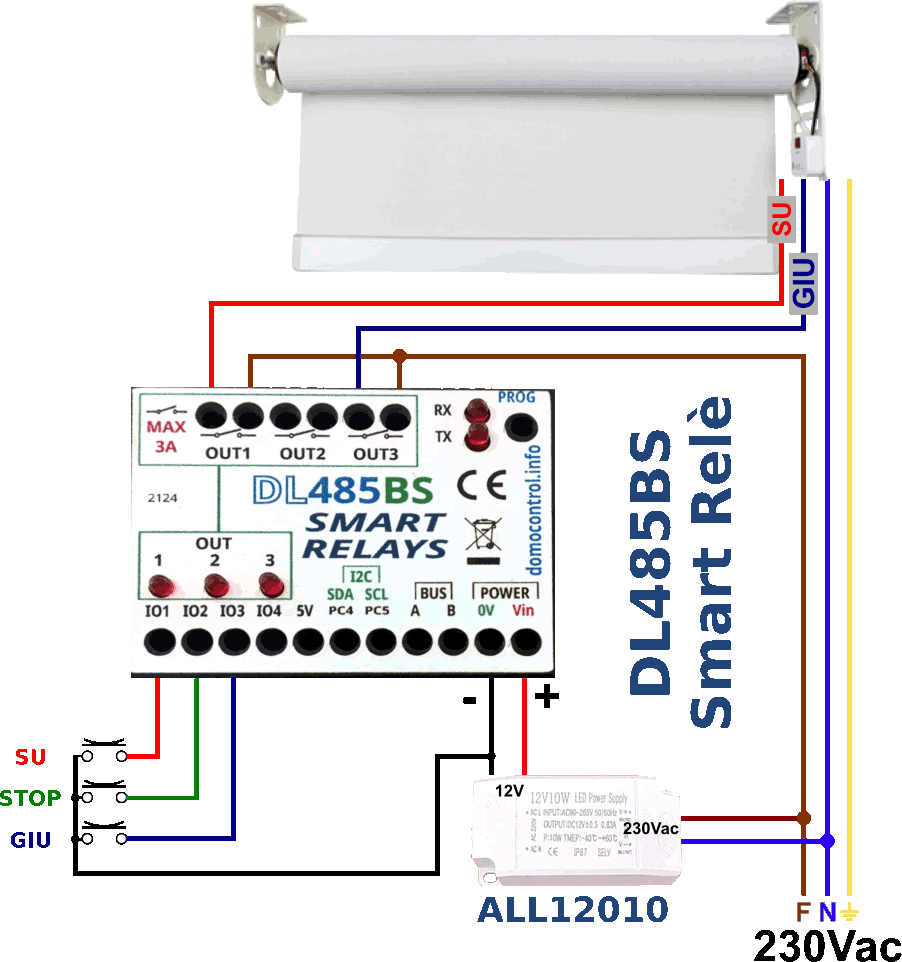
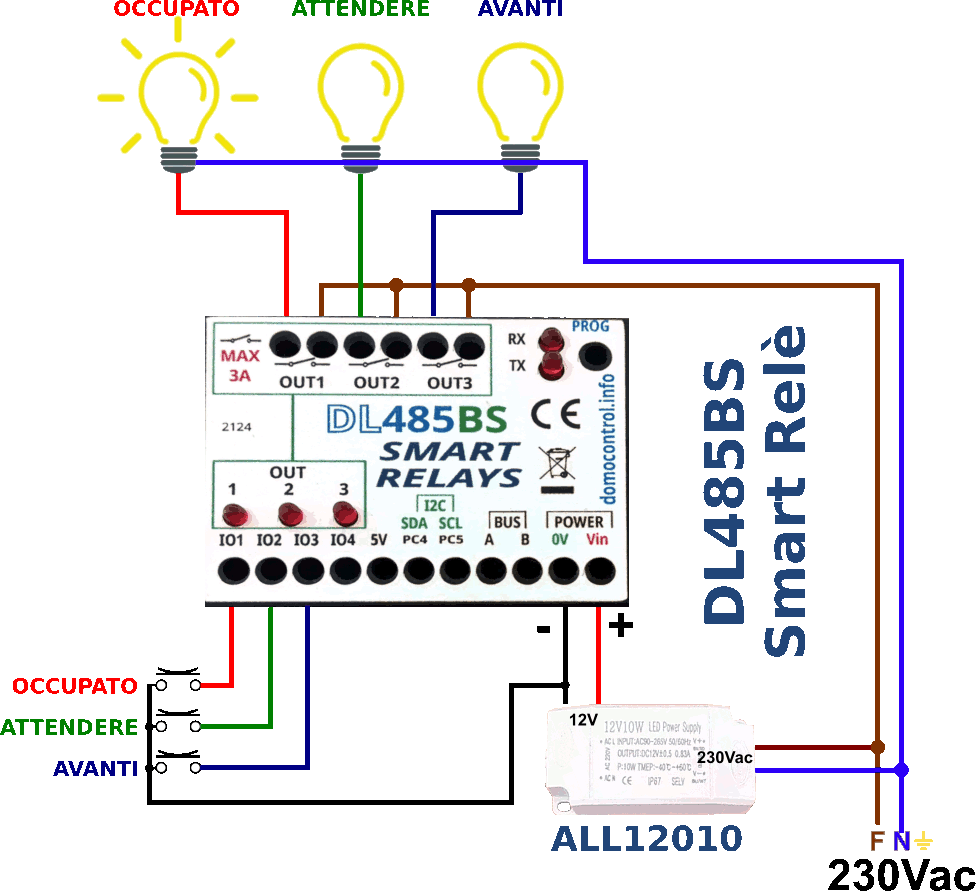
STUDIO LIGHT BUSY-WAIT-FORWARD
This use case is similar to the forward-stop-reverse motor control with the difference that all three outputs will be connected and there is no need to go through the completely off state, i.e. switching between the various lights can be immediate.FLASHING
Different flashing modes are possible, which starts when power is supplied and / or via a button control, which stops with a button, which goes on only for a certain number of flashes, which ends on or off, which begins with time off or with time on.In this example relay 1 has been used and the other 2 are free for other applications.
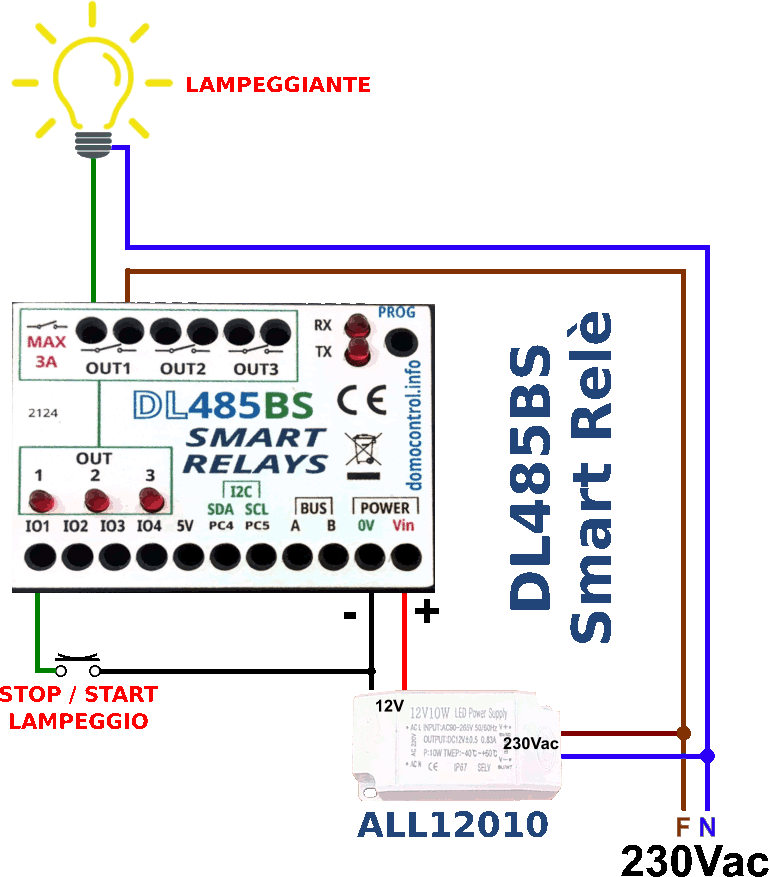
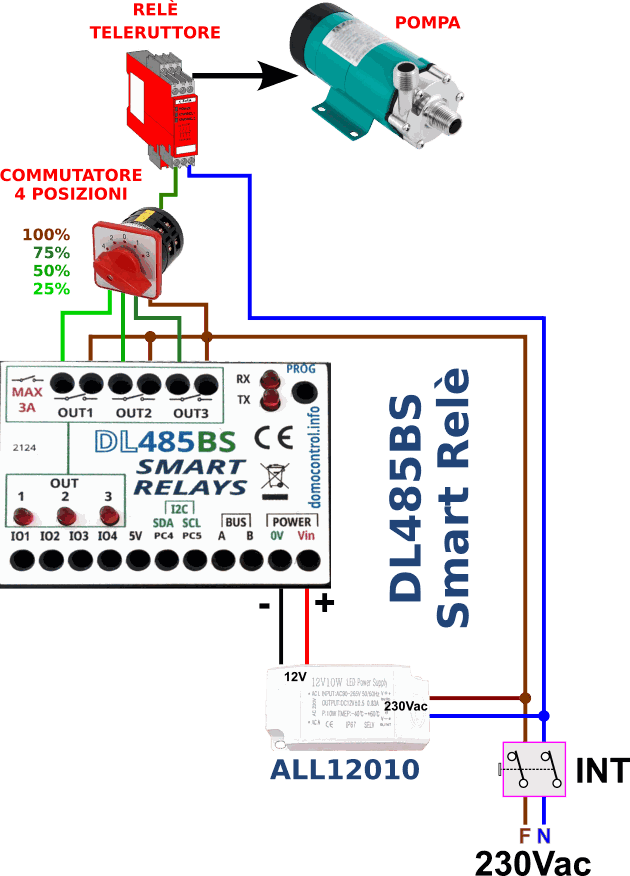
REDUCTION OF THE AVERAGE FLOW OF A PUMP WITHOUT USING INVERTER
Sometimes you need a pump that delivers less water than its nominal flow rate, if you do not use an inverter to regulate it, you can use a command that has a working time and a rest time, such as a flashing light, so on average it is possible to reduce the stream of water. Pay attention to the inrush of the pump which can be higher than the capacity of the smart relay contacts therefore this unit must be used to drive a relay with a higher capacity. If the load is three-phase, the three channels of the smart relay can be used, set and controlled in the same way, as long as the load current is low enough, otherwise a three-phase contactor will be used. A more advanced solution can be to set the 3 channels respectively to 25%, 50%, 75%, then with a selector select which output to use to drive the pump or the remote control, and if the selector has 4 positions, it can be added even 100% and with a fifth position even 0%.
RING TONE WITH COURTESY LIGHT
(USEFUL ALSO FOR THE DUDE)
The bell output is connected as a dead man, while the light output is a timed output and the button controls both inputs.
Whoever rings the bell will be illuminated for a certain time by the courtesy light, also useful for seeing who is from the window or from a camera.
This light can also be duplicated inside the house to let deaf people know that they have rang.
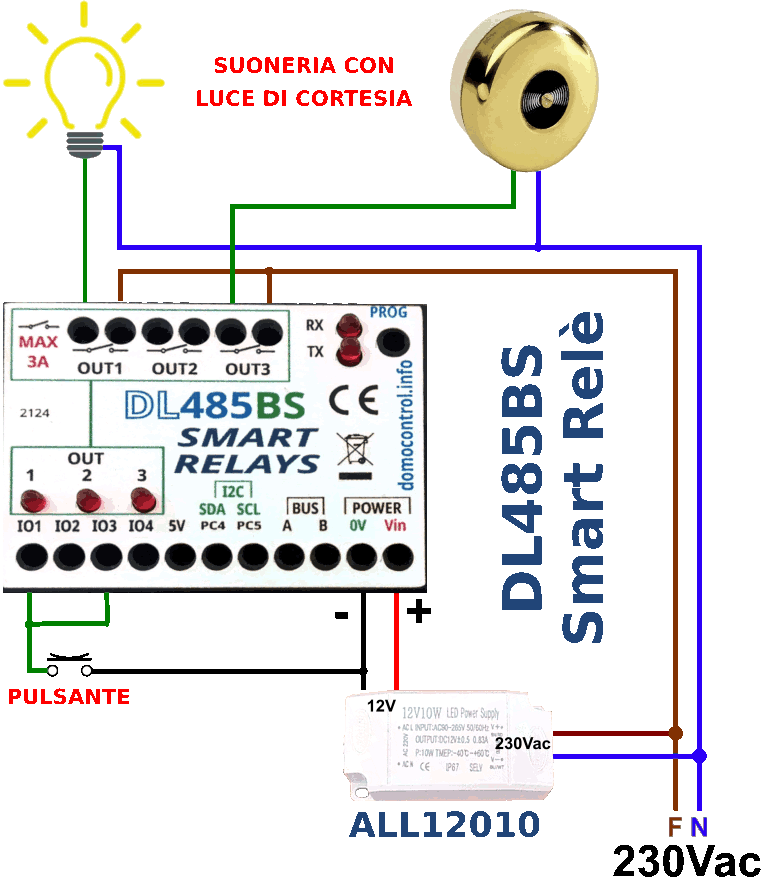
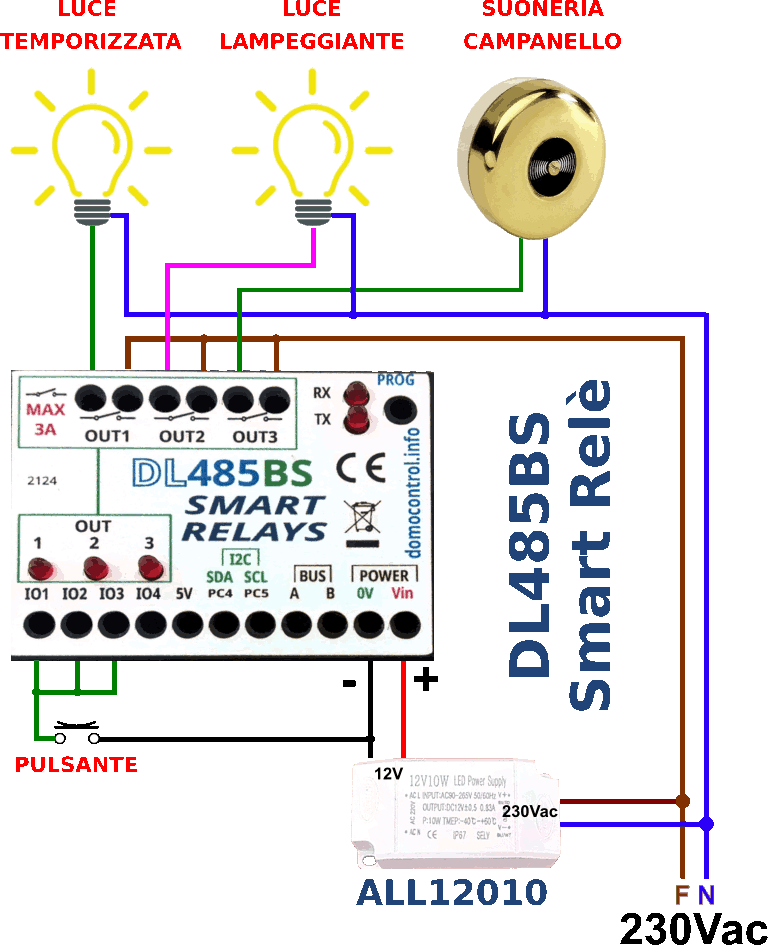
VISUAL SIGNAL OF BELL PRESSED FOR A LITTLE OR LONG TIME (USEFUL ALSO FOR THE HEARING)
Using the 3-relay unit it is possible to control a bell, a courtesy light and a flashing light. The ringtone must be controlled in dead man mode, the courtesy light is a simple timed light, while the flashing light must flash a certain number of flashes in order to signal to people with hearing problems that someone has rang the bell.It is possible to set a number of flashes such that at the end of the series the flashing light remains on or off, if you choose to stay on you will have an added visual indication, that is, if it still flashes it has been played for a short time, if instead the light is fixed has been played for the longest time. To turn off the flashing or steady light, the unit can be reset by removing the power supply for a moment.
FORWARD REVERSE CONTROL FOR SMALL DIRECT CURRENT MOTORS
This use case requires reversing the polarity of the power supply to the motor, so the device with two diverter relays was used.With this solution it is possible to control forward / stop and reverse / stop using the toggle function, furthermore it is possible to give a maximum operating time even different for the two directions and it is possible to switch directly from forward to reverse with or without braking pause.
Pay attention to the starting current of the motor, if it is too high for the contacts of the smart relay it will be necessary to use two external relays of adequate capacity. If a single button stop command is required, the three-channel smart relay must be used and two external relays must be piloted with the diverter contact.
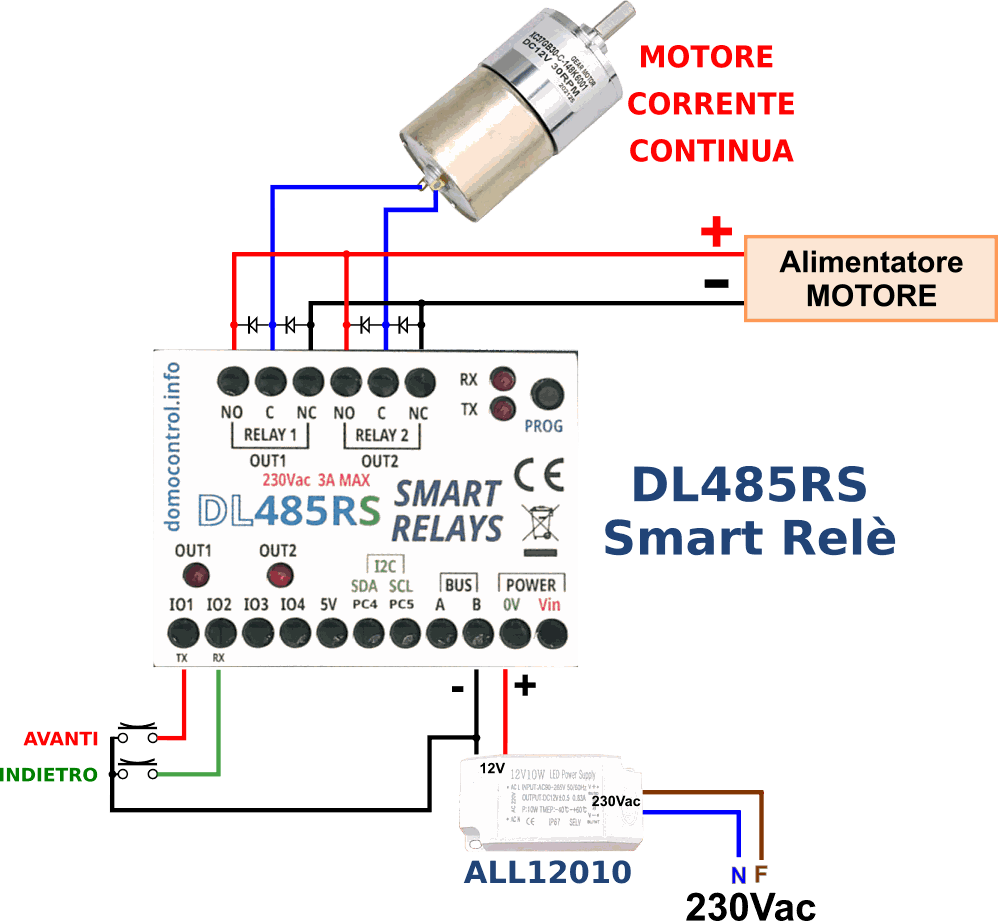
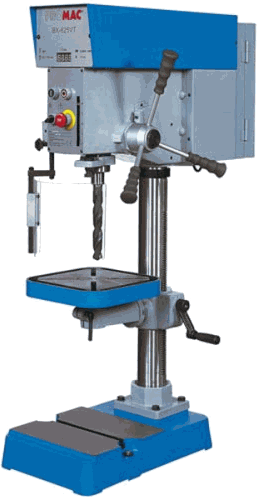
MASCHIATORE CON TRAPANO A COLONNA
Applicazione dello smart relè per il comando della rotazione del motore di un trapano a colonna adattato per filettare con maschio sul mandrino.
Esempio dettagliato su come si può risolvere questa automazione
- maschiatore fatto su un trapano a colonna con maschio per filettare montato sul mandrino
- una puleggia con una camma comunica il fatto che la leva manuale comincia a scendere
- la camma è lunga e tiene premuto il finecorsa alto per tutta la corsa di discesa
(la camma lunga serve anche a stabilire se la posizione sia sotto o sopra l’inizio della camma)
- quando il mandrino arriva a fine corsa di maschiatura la camma preme il finecorsa basso
Logica prevista per il controllo:
- quando la leva comincia a scendere e preme il finecorsa alto il maschio si mette in moto per filettare
- se si rialza la leva prima di filettare, il maschio si deve fermare
- quando si arriva a fine filetto la camma tocca il finecorsa basso e il maschio si ferma un attimo poi gira al contrario per consentire la risalita
- quando si libera il finecorsa alto il maschio si deve fermare
Collegamento elettrico del motore a corrente continua:
- il centrale del contatto deviatore comandato dal relè 1 è collegato al polo del motore che col + farebbe girare nel senso di maschiatura
- il centrale del contatto deviatore comandato dal relè 3 è collegato al polo del motore che col + farebbe girare per svitare il maschio
- il contatto NO di ogni deviatore è collegato a +VCC
- il contatto NC di ogni deviatore è collegato a 0Vcc
Per ridurre archi e disturbi è consigliabile collegare un ponte a diodi con i morsetti alternata del ponte sui morsetti + e - motore e i morsetti + e – del ponte al + e – dell’alimentazione.
Quando entrambi i relè sono spenti o accesi il motore è in cortocircuito se invece uno è acceso e uno spento il motore è alimentato col +VCC sul filo dove il relè è acceso.
Fasi di funzionamento del motore nel ciclo normale:
1 - motore spento
2 - pressione FC alto: motore gira in senso di maschiatura
3 - pressione FC basso: motore spento per un attimo
4 - motore gira per risalita
5 - si libera FC alto: motore spento
Programmazione smart relè:
(nessun relè viene impostato per fare cicli, si collegano insieme ingressi 1 e 2, il relè 2 non viene collegato, ma serve a spegnere tutto a fine ciclo)
Programmazione relè 1: (comanda motore in senso maschiatura)
- parametri 1,2,3,4,6,10,11: ignorati a causa delle impostazioni seguenti
- parametro 7: avvio all'alimentazione, valore 3: Uscita spenta e programmabile
- parametro 8: gestione fronti in ingresso a ciclo fermo e uscita ON, valore 0: Nessun innesco
- parametro 9: gestione fronti in ingresso a ciclo fermo e uscita OFF, valore 7: Innesco su fronte ON, inverte uscita e ciclo fermo
- parametro 12:Modo di conteggio tempi, valore 0: Normale
- parametro 13:Ritardo per spegnere altre uscite prima di accendere, valore 1: Spegne altre uscite se accese e non aspetta
Programmazione relè 2: (ausiliario di spegnimento totale)
- parametri 1,2,3,4,6,10,11: ignorati a causa delle impostazioni seguenti
- parametro 7: avvio all'alimentazione, valore 3: Uscita spenta e programmabile
- parametro 8: gestione fronti in ingresso a ciclo fermo e uscita ON, valore 0: Nessun innesco
- parametro 9: gestione fronti in ingresso a ciclo fermo e uscita OFF, valore 8: Innesco su fronte OFF, inverte uscita e ciclo fermo
- parametro 12:Modo di conteggio tempi, valore 0: Normale
- parametro 13:Ritardo per spegnere altre uscite prima di accendere, valore 1: Spegne altre uscite se accese e non aspetta
Programmazione relè 3: (comanda motore in senso inverso di maschiatura)
- parametri 1,2,3,4,6,10,11: ignorati a causa delle impostazioni seguenti
- parametro 7: avvio all'alimentazione, valore 3: Uscita spenta e programmabile
- parametro 8: gestione fronti in ingresso a ciclo fermo e uscita ON, valore 0: Nessun innesco
- parametro 9: gestione fronti in ingresso a ciclo fermo e uscita OFF, valore 7: Innesco su fronte ON, inverte uscita e ciclo fermo
- parametro 12:Modo di conteggio tempi, valore 0: Normale
- parametro 13:Ritardo per spegnere altre uscite prima di accendere, valore 6: Spegne altre uscite, aspetta 30 centesimi poi accende
Man Present
Switch on / off by button or switch, also reversed
Step by step relay
Switch on / off by button
Stair lights
With programmable, fixed, rechargeable or summable maximum time
Timer
Multiple types of configurable timers
Flashing
ON / OFF time programming, number of flashes ....
Mutual exclusion
Motor: Forward / off / reverse.
Access to doctors' offices: Busy / Wait / Forward
Application examples
The elderly person with shopping bags who needs more time to climb stairs can press the light button three times for triple time;
In a condominium, a person who has to go down or up the stairs, finding the light already on, can make sure that he has time to get to his destination with the option of recharging the timer or adding time;
In a condominium, during the cleaning of the stairs, you need a long time to avoid having to turn the light back on continuously during work;
In a condominium with two lines of paired stair lights, by switching off the first one, you can give the switch-off notice for the second line;
In condominiums with a staircase light line, lights can be switched off for 0.3..0.5 seconds as a notice of time expiration;
If you want a timed light in an old system where there is already a switch or a two-point command with diverters, and you don't find buttons of the same aesthetic shape, you can get the same on / off + timer function using the existing commands. with diverters / switches and triggering the timer on the ON / OFF variation edges of the input;
In the event of voltage fluctuations during thunderstorms or in the case of systems with lamps that must not be re-ignited when hot, reconnection to the electricity grid can be delayed after the energy has been restored;
Returning from an absence, you could have a steady green light if there has never been a power failure and / or a flashing red light otherwise;
Control of the motor of an up / down / stop awning with maximum operating time in both directions and pause in changing from one to the other;
Courtesy indicator command, closed / wait / forward, at the door of a medical or professional office.
Visual indication that a bell has been rung, useful for the deaf or for people who arrive after the sound.
To start three-phase motors in the star-delta connection, you must first connect the motor in star for the first starting phase, then when you switch to delta you have to wait a moment for the star to release before connecting in delta.

DL485BS - Smart Relay with 3 clean contact outputs
GO TO THE ProdUCT
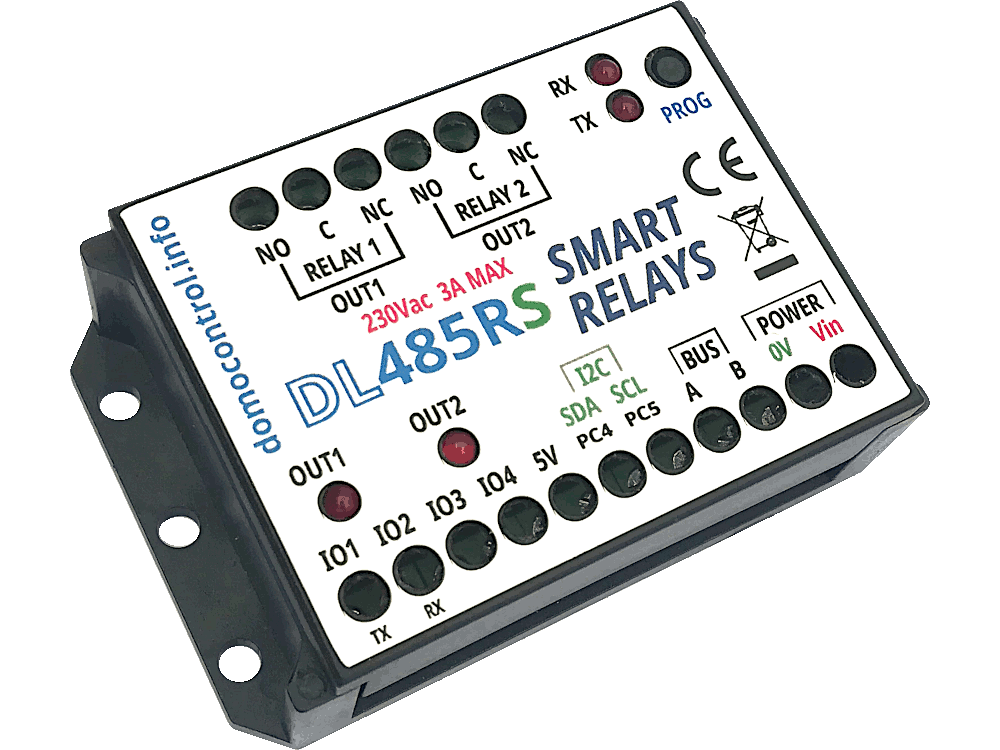
DL485RS - Smart Relay with 2 diverter outputs
GO TO THE prodUCT
Smart Relay demostration video
Video
Smart Relè
Relè intelligenti programmabili per molteplici usi, disponibili in 2
versioni: 3 contatti puliti oppure 2 deviatori, con funzionamento
autonomo e/o integrabile in rete 485 con Domoticz.
Si possono ottenere le funzioni di relè passo passo, relè temporizzato e relè intermittente, inoltre i cicli di funzionamento possono essere avviati dal relativo ingresso o dall'arrivo della tensione di alimentazione, e possono essere anche fermati dall'ingresso o dall'accensione di un altro relè.
VIDEO PER ARGOMENTI:
INTRODUZIONE -> https://www.youtube.com/watch?v=PAvYpeJVS1E&t=14s
COMANDO LUCI SCALE -> https://www.youtube.com/watch?v=PAvYpeJVS1E&t=56s
RELE PASSO PASSO IN VARI MODI -> https://www.youtube.com/watch?v=PAvYpeJVS1E&t=174s
RELE PASSO PASSO OCCUPATO ATTENDERE AVANTI -> https://www.youtube.com/watch?v=PAvYpeJVS1E&t=197s
PROGRAMMAZIONE SMART RELE -> https://www.youtube.com/watch?v=PAvYpeJVS1E&t=4m46s
LAMPEGGIANTI -> https://www.youtube.com/watch?v=PAvYpeJVS1E&t=9m51s




